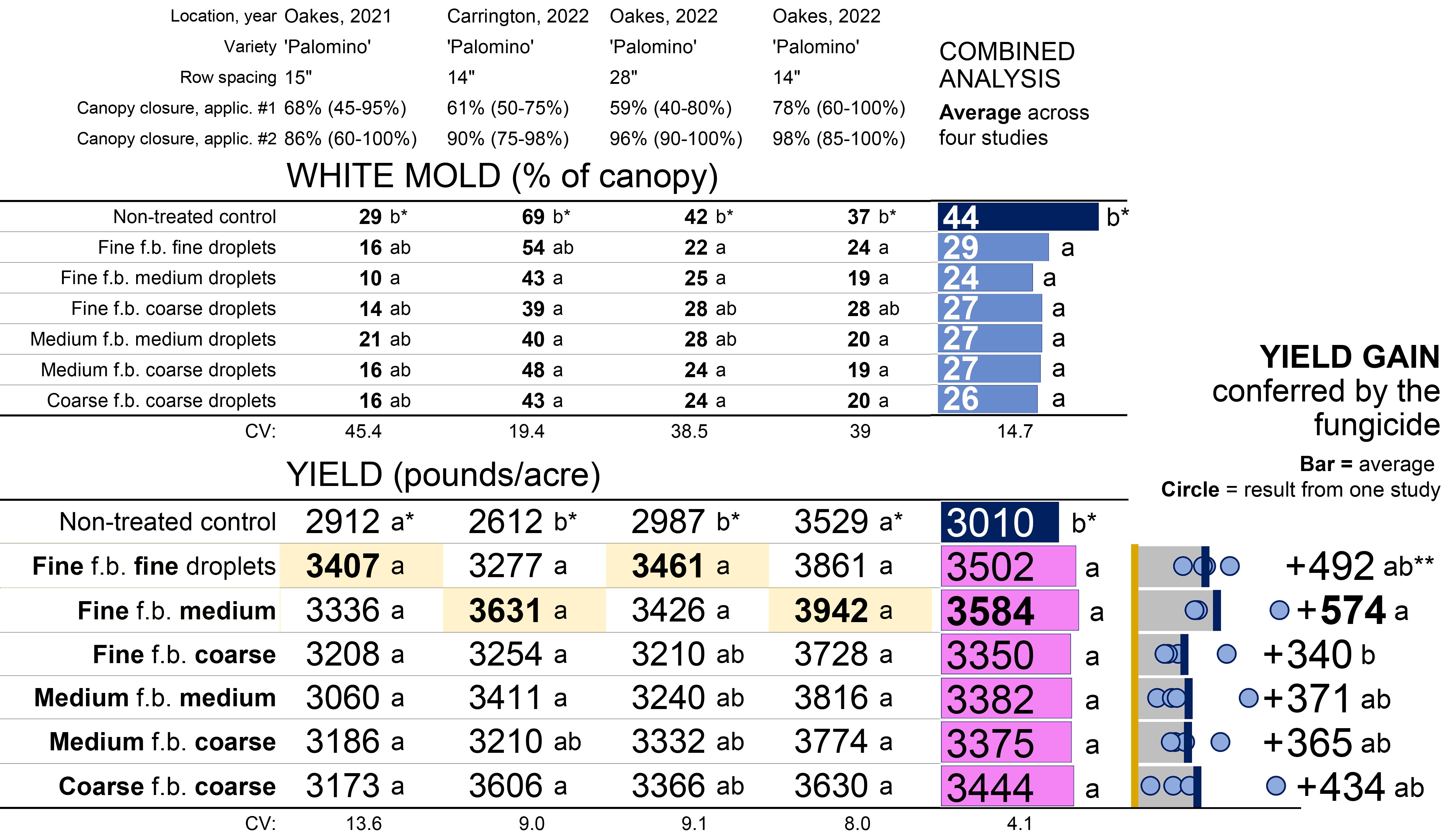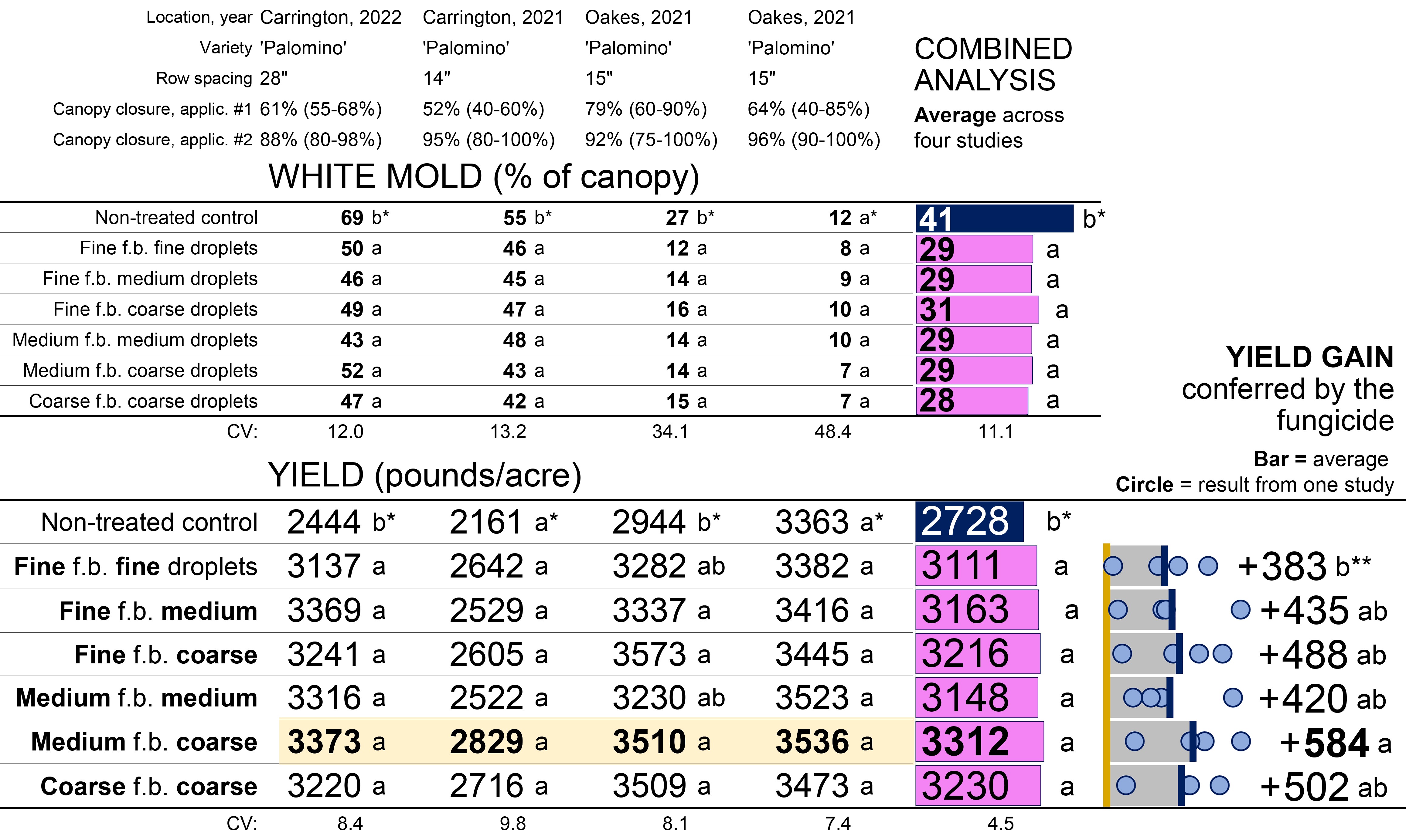Calibrating fungicide spray droplet size relative to canopy closure confers strong improvements in fungicide efficacy against white mold in soybeans, and this research sought to evaluate whether a similar response might be observed in pinto beans.
The impact of fungicide spray droplet size was tested with a PTO-driven tractor-mounted sprayer equipped with a pulse-width modulation system (Capstan AG; Topeka, KS). Pulse width was modified as needed to maintain a constant spray volume (15 gal/a) and constant driving speed across nozzles differing in output, with pulse width calibrated on the basis of measured output immediately before spraying treatments. The fungicide Topsin or T-methyl (40 fl oz/a) was applied at early bloom followed by Endura (8 oz/a) 11-14 days later. Applications were made at 6.0, 10.0, or 10.5 mph, depending on the study, using TeeJet extended-range flat fan nozzles. Fungicides were applied with XR11004 or XR11005 nozzles at 60 psi (fine droplets); XR11006 nozzles at 35 psi (medium droplets), and XR11010 nozzles at 30 psi (coarse droplets). To permit overspray of plots, treatment plots were bordered by 5- or 10-foot wide non-harvested plots. On ends of each treatment plot, a non-harvested plot was established to permit turning on and off the sprayer at full driving speed. Dry beans were seeded to rows 14, 15, or 28 inches apart at a seeding rate of 90,000 viable seeds. Seven treatments were evaluated: Non-treated, fine followed by fine droplets, fine followed by medium droplets, fine followed by coarse, medium followed by medium, medium followed by coarse, and coarse followed by coarse. All testing was conducted under conventional tillage except in Oakes in 2021, where testing was conducted with dry beans direct-seeded into fallow ground, into winter rye with rye terminated 12 days prior to planting, and into winter rye terminated 2 days after planting. To ensure rigorous results, testing was conducted with 8 to 12 experimental replicates.
The droplet size that optimized fungicide performance was contingent on canopy characteristics. In four studies, yields were maximized with fine droplets at the first application and fine or medium droplets at the second application (Figure 1). In four studies, yields were optimized with medium droplets at the first application and coarse droplets at the second application (Figure 2). Visual estimates of canopy closure were similar across these eight studies, and additional research is needed to identify the canopy characteristics when fine droplets vs. medium droplets are optimal in the first application. When canopy closure averaged 94% at the first application and 97-99% at the second application, yields were optimized with coarse droplets at both applications (Figure 3).
Figure 1. Applying fungicides with fine droplets at the early bloom and fine or medium droplets 10-14 days later optimized yields in four studies. T-methyl (40 fl oz) was applied first followed by Endura (8 oz) 10-14 days later. Within-column means followed by different letters are significantly different (P < 0.05) or (P < 0.10) if followed by two asterisks.
Figure 2. Applying fungicides with medium droplets at the early bloom and coarse droplets 10-14 days later optimized yields in four studies. T-methyl (40 fl oz) was applied first followed by Endura (8 oz) 10-14 days later. Within-column means followed by different letters are significantly different (P < 0.05) or (P < 0.10) if followed by two asterisks.
Figure 3. Applying fungicides with coarse droplets at the early bloom and coarse droplets 10-14 days later optimized yields in three studies. T-methyl (40 fl oz) was applied first followed by Endura (8 oz) 10-14 days later. Within-column means followed by different letters are significantly different (P < 0.05).


